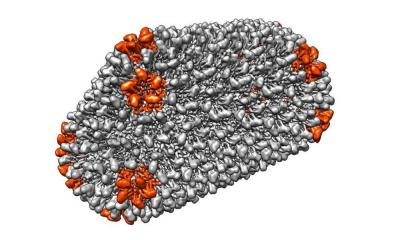Infectiology
Immune factor allows viral infections to become chronic
Many viral diseases tend to become chronic – including infections with the HI virus. In persons affected, the immune response is not sufficient to eliminate the virus permanently. Scientists at the University of Bonn have now identified an immune factor which is partially responsible for this. Their results give rise to hopes for new therapeutic approaches. The work, which included researchers from the University of Cologne and the Technical University of Munich, is being published in the renowned journal "Nature Immunology."

The HI virus triggers the immunodeficiency disease AIDS. The infection has a chronic course – the immune system is not able to get rid of the pathogen. This is due among other things to the fact that the virus directly attacks and destroys certain immune cells known as helper T cells.
However, many helper T cells are not affected by the virus at all. Nonetheless their function is impaired in the case of AIDS. Normally, helper T cells secrete inflammatory messengers during an infection. As a result of this chemical distress call, killer T cells (the body's own defense troops) become ready to fight and are guided to the site. By contrast, in AIDS and other chronic infections, the helper T cells remain silent. But why is that?
To answer this question, the researchers initially analyzed which genes in the silent helper cells of HIV patients are active. Result: In chronic inflammation, the immune function of the helper T cells is inhibited by various signaling pathways. These signaling pathways in turn are apparently controlled by a single molecule known as tumor necrosis factor (TNF).
This factor appears to be responsible for the weak immune response. "We investigated mice suffering from a chronic viral infection similar to an HIV infection and inactivated the TNF molecule in them," explains Dr. Marc Beyer from Life and Medical Sciences Institute (LIMES) of the University of Bonn. "As a result, the helper T cells worked normally once again. After ten days, the animals had completely eliminated the virus; they were healthy."
Misdirected protective function
Paradoxically, the tumor necrosis factor has exactly the opposite effect in acute viral attacks: It brings the immune system up to full speed and additionally ensures that cells infected with the virus commit suicide. "Therefore, in an acute infection, large quantities of TNF are formed very rapidly," says Dr. Zeinab Abdullah from the Institute of Experimental Immunology at the University Hospital Bonn. "In chronic infections, on the other hand, the body secretes small amounts of TNF over a long period of time. This appears to cause the helper T cells to shut down to some extent."
The researchers suspect that this is a protective mechanism. A prolonged strong immune reaction can in particular destroy healthy tissues as well – with life-threatening consequences. TNF could act as a type of emergency brake which prevents this. Exactly what the tumor necrosis factor does on a molecular level is still largely unknown. The scientists involved now want to examine this question in detail.
The results may establish new therapeutic options in the medium term. Thus there are drugs which inhibit the effect of TNF. These TNF blockers are used in the treatment of autoimmune diseases such as rheumatism, for example. They are to prevent defense cells from attacking the body itself. "Among other things, we want to investigate what effects these drugs have in rheumatism patients who are additionally suffering from a chronic viral infection," says Marc Beyer.
Source: LIMES Institute of University of Bonn
16.03.2016











